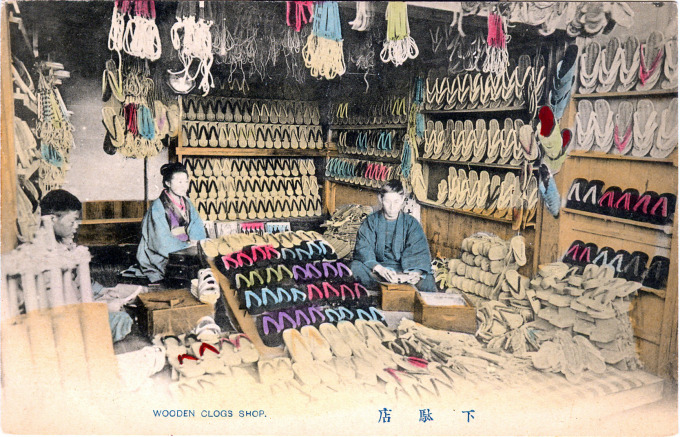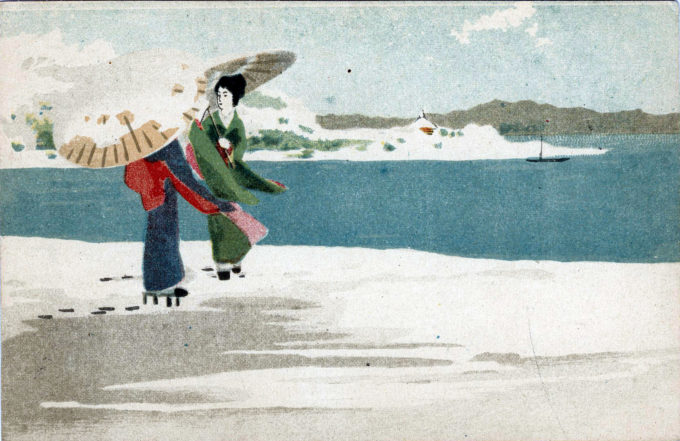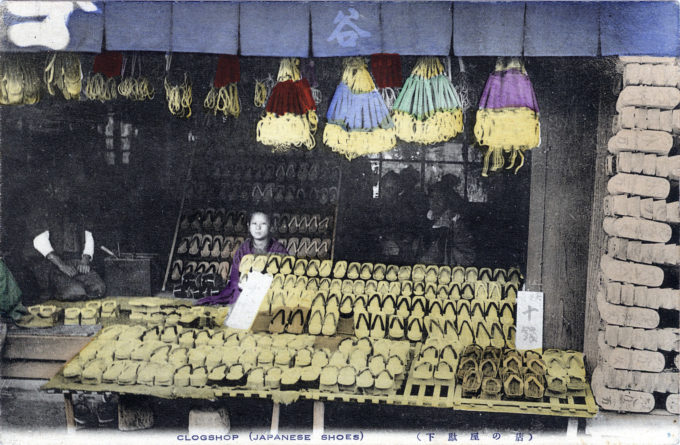See also:
Changing fashion (Western dress), c. 1910
Changing Fashion (Coiffure), c. 1910
Changing Fashion (Sokuhatsu), c. 1910
Changing fashion (Swimsuit), c. 1920
Wedding fashion, c. 1930
“The clapping of hands has ceased; the toil of the day begins; continually louder and louder the pattering of geta over the bridge.
“It is a sound never to be forgotten, this pattering of geta over the Ohashi – rapid, merry, musical, like the sound of an enormous dance; and a dance it veritably is.
“… Merely to stand upon a pair of geta is difficult for one unaccustomed to their use, yet you see Japanese children running full speed in geta with soles at least three inches high, held to the foot only be a forestrap fastened between the big toe and the other toes, and they never trip and the geta never falls off.”
– Glimpses of an Unfamiliar Japan (First series), Lafcadio Hearn, 1891
“Geta are a form of traditional Japanese footwear that are a kind of sandal with an elevated wooden base held onto the foot with a fabric thong to keep the foot well above the ground. They are worn with traditional Japanese clothing such as kimono or yukata, but (in Japan) also with Western clothing during the summer months.
“Sometimes geta are worn in rain or snow to keep the feet dry, due to their extra height and impermeability compared to other footwear such as zōri. The practical reason for wearing these very high platform shoes were not for fashion: If one were to wear a very expensive kimono that hangs all the way down to the feet, they would not want to get mud on it when they walk outside.
“Maiko [geisha-in-training] wear distinctive tall geta called okobo which are similar to the chopines worn in Venice during the Renaissance. Japanese professional sumo wrestlers in the lowest two divisions of Jonokuchi and Jonidan must wear geta with their yukata at all times. The clacking sound that geta make when walking is consequently something aspiring sumo stars wish to leave behind as soon as possible.
“Geta designs vary widely according to use. Pokkuri geta are for young girls and have curved-in bottoms that create a beautiful noise when used; koshi geta are used in the rain; yuki geta are designed so as to not catch or hold snow; niwa geta are for use in the garden; nori geta are used by seaweed harvesters in the water; suberi geta are used for skating; butai geta are used by Bunraku puppeteers.
“Geta made in the traditional way use a wood resistant to rot: Paulownia (from the family Paulowniaceae) from Kitakata and Aizu (in Fukushima Prefecture), said to have the best quality stands of Paulownia forests in Japan. Each of the three or four stages of construction is performed by a separate artisan [jikataya]. The straps [hanao] are also made by artisans using special tools to slip and tie that hanao through the three holes in each clog.”
– Wikipedia





Pingback: Ueno Station, c. 1910-1920. | Old Tokyo
Pingback: Tokyo "Black Markets", 1945. | Old Tokyo